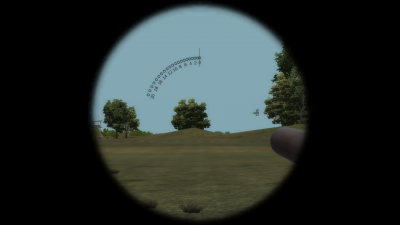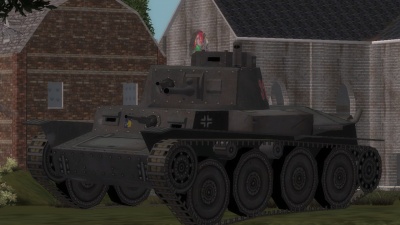Panzerkampfwagen 38(t)
History

| |
| Main Gun Optics | |
| Specifications | |
| Designation | TZF 38(t) |
| Magnification | 2.4x |
| Field of View | 25° |
No set of vehicles of foreign design and manufacture were more important to the German Panzertruppen (armored forces) during the early years of World War II than those commandeered from Czechoslovakia (CSR) when Germany completely occupied it in Mar. 15, 1939 (see Munich Agreement). Had Germany not acquired the Czechoslovakian tank fleet and the manufacturing capacity of both the Skoda and Ceskomoravska-Kolben-Danek (CKD) plants, it probably would have not been able to muster the resources to go to war later that year (Czechoslovakia's manufacturing capacity rivaled that of Germanys at the time). Despite Germany’s considerable secret efforts during the 1930s to equip newly formed Panzer divisions with effective homegrown equipment, the German Wehrmacht was woefully short of effective combat vehicles, a fact the invasion of Poland in September 1939 underscored.
In 1938, the Czechoslovakian army had held a light tank design competition in which six prototypes took part. One of CKD’s entrants, the TNHP-S, won. The army ordered the design, designated the LT vz 38, into immediate production in July 1938. It had agreed to initially buy 150 but the September 29, 1938 Munich Agreement delayed production and none had been completed by the time German forces rolled into the country in March 1939. The German occupiers confiscated the first nine LT vz 38s to roll off the assembly line. The new vehicles so impressed them that they instructed CKD, by now renamed Böhmisch Mährische Maschinenfabrik AG (BMM), to finish the initial order of 150 and start work on a further 325. In the Wehrmacht, this tank would be known as the Panzerkampfwagen (Armored Fighting Vehicle) 38(t), shortened to PzKpfw 38(t). The letter in brackets designates the country of origin, in this case "Tschechoslowakei" the German writing of "Czechoslovakia".
The PzKpfw 38(t) proved superbly reliable and easy to maintain. It was estimated during the war that the 38(t) could travel approximately three times farther than its German-designed, German-built equivalents before needing major service. Its simple, rugged design used fewer components and was therefore easier to manufacture and maintain than just about any comparative German tank. The Czechoslovakian 3,7cm Kw.K. 38(t) A7 L / 47,8 cannon this tank carried outperformed German weapons of equal caliber. The PzKpfw 38(t) became the one of the Wehrmacht’s most important tanks in the early years of the war, and arguably the reason for success of the Blitzkrieg.
The Ausf. A model made up the bulk of the first order of 150. Powered by a Praga EPA six-cylinder, 7.75L engine delivering 125hp at 2200 revolutions, this tank featured a maximum armor thickness of 25mm and armament of the 3,7cm Kw.K. 38(t) A7 L / 47,8 and two 7,92 mm MG 37(t) machine guns, one in the turret and one in the hull.
The second batch of 325 included Ausf. B, C, and D models. The Ausf. B and C introduced the drivers' curved plate and deleted the battle aerial. The Ausf. D introduced anti-splash bullet protection for the turret ring.
After battle experience in Poland and France, the Ausf. E and F acquired extra armor plate welded to the front chassis and turret. Other than that these variants were virtually identical to the Ausf. D. The weight of the vehicle, due to the extra armour, increased to nearly 9,850 kg.
The Ausf. S designation was put to a batch of 90 tanks that were built for export to Sweden, but were delivered to the Slovak Free State instead. These tanks fought against the Soviets during 1941 and 1942. Sweden then set about negotiating with BMM and the German government to build the PzKpfw 38(t) under license.
The last variant, the Ausf. G, incorporated a single thick plate of armour matching the compound plates of the Ausf. E and F in total thickness. A total of 1,411 PzKpfw 38(t)s were eventually produced in eight variants: Ausf. A-G and S.
PzKpfw 38(t)s were issued to front-line Panzer divisions, which fought with them extensively in Poland, Denmark, Norway, France, and during the early Russian campaign. Both 7. Panzer-Division and 8. Panzer-Division received their PzKpfw 38(t)s in time for the invasion of western Europe. Rommel’s 7. Panzer-Division - nicknamed the Gespensterdivision (Ghost Division) - gained fame for its rapid advance through France during May 1940.
The PzKpfw 38(t) formed the backbone of the Panzertruppen during the early years of World War II and the great initial successes of the Panzer divisions can be directly attributed to their mounts.
By 1942, however, the PzKpfw 38(t) would be totally outclassed by heavier and more powerful Allied vehicles. Even as the design reached the limits of usefulness as a main battle tank, the simple, rugged, and reliable chassis was the base vehicle for dozens of variants, including the famous Hetzer tank destroyer. It also proved attractive for its economy, with a Swedish variant, the Sav m/43, remained in use until 1970, which is probably a longevity record for a pre-WW2 tank.
Game Play
The PzKpfw 38(t) is a superior light tank, with good mobility and an exceptional small-caliber gun. Many dedicated tank players realize the attributes of this little tank when employed correctly, and are indeed deadly and effective with it. Those less knowledgeable about early war tanks may overlook it as not “cool” like other German tanks and fail to recognize its potential. It may be the best German anti-tank armoured platform in the early days of a campaign, although it cannot compete with the 50mm and long 75mm guns that form the mainstay of tank designs in the latter stages of the war.
The tank is built with a small chassis and is short in wheelbase so it may pitch a lot over rough ground. The powerful optics and flat shot from its high muzzle velocity 37mm means that accurate fire is easy and potent against all but the really thick armor of the Matilda II and B1 bis, both of which demand you close to absurdly close before you can expect success. Still, that's better than no chance at all.
When firing from a halt, even full braking can't stop the lightweight 38(t) from a slight shimmy. It can help to shift into neutral before firing.
Your commander position is vital, since this is also your gunner position. It is rarely worth the risk of unbuttoning the commander for a better view. If unbuttoned, a single enemy with a pistol in the wrong place could effectively disable your entire tank as a fighting vehicle. If you must unbutton, one feature that will help is that the unbuttoned commander doesn’t stick up too high out of the turret, making him a slightly tougher target for snipers.
The 38T is available from tier 0.
Armor
| Location | Thickness | Angle |
|---|---|---|
| Hull front | 25 mm | 16° |
| Hull sides | 15 mm | 0° |
| Hull rear | 15 mm | 12° |
| Hull top | 8 mm | 90° |
| Superstructure front | 25 mm | 17° |
| Superstructure sides | 15 mm | 0° |
| Superstructure rear | 10 mm | 60° |
| Superstructure top | 8 mm | 90° |
| Turret front | 25 mm | 10° |
| Turret sides | 25 mm | 10° |
| Turret rear | 15 mm | 10° |
| Turret top | 10 mm | 90° |
| Gun mantlet | 25 mm | round |
